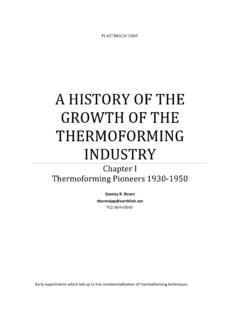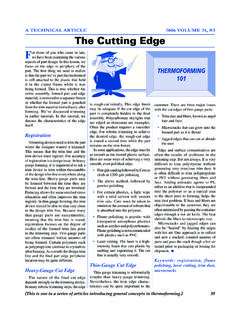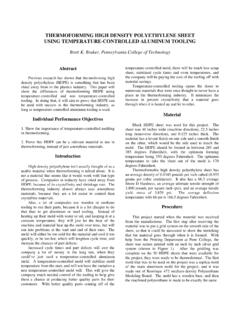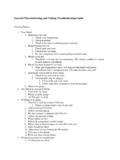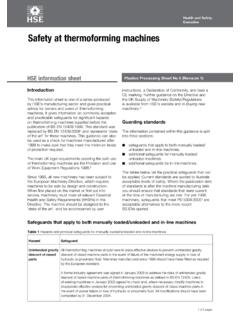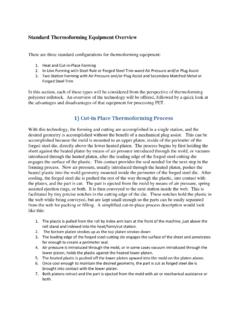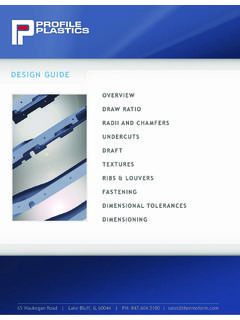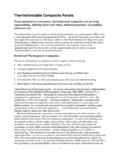Transcription of A TECHNICAL ARTICLE 2005 VOLUME 24, #4 The …
1 [This is one in a series of articles introducing general concepts in thermoforming .]A TECHNICAL ARTICLE 2005 VOLUME 24, #4 Probably the first thing a novice hears in thermo-forming after he/she learns to spell thermoforming , is the phrase, Draw Ratio. So, this lesson focuses on the concept of draw There More Than One Definition? Unfortunately, yes. There are at least three definitions. Let s define the common ones. Areal Draw Ratio, often given the symbol RA, is the ratio of the area of the part being formed to the area of the sheet needed to make the part.
2 Although I promised not to use equations in our TF 101 lessons, some simple ones here won t hurt all that much:RA = AreaPart/AreaSheet A simple example, please? Consider a cylinder one unit in diameter by one unit high. The area of the cylinder is ( + /4) = 5 4. The area of the sheet used to form the cylinder is /4. Therefore the areal draw ratio, RA, is 5. As an interest-ing aside, the reciprocal of the areal draw ratio is the average reduced thickness of the formed part, being 1/5 = In other words, the original sheet thick-ness has been reduced by 80%, on the average.
3 Linear Draw Ratio, often given the symbol RL, is the ratio of the length of a line scribed The Ubiquitous1 Draw Ratioon the part surface to the origi-nal length of the line. Again, in equation form:RL = LinePart/LineSheetFor the same example, the length of the line on the cylinder is (1+1+1) = 3. The original length of the line is 1. Therefore, the linear draw ratio, RL, is 3. The linear draw ratio is akin to the way in which the plastic is stretched in a tensile test machine, Height-to-Diameter Ratio, often written as H:D, is the height of the cylinder (1), to the diameter of the cylinder (1).
4 Or H:D = 1. H:D is used primarily for axisymmetric2 parts such as cones or cylinders, such as drink cups. In summary, for the cylinder described above, RA=5, RL = 3, and H:D = 1. So you see, there is no agreement between these Draw Ratios of Use? Importance? So, which one do we use? Depends. First, we need to determine whether draw ratio is a useful concept. Let s focus on areal draw ratio to determine its utility. As we have already learned, the reciprocal of RA is the av-erage reduced thickness.
5 But where is this reduced thickness? Somewhere down the side of the formed part. In fact, there is probably a line around the periphery of the part where the part thickness is exactly the average reduced thickness. So, what does this tell us about the uniformity of the part wall thickness? Or the degree of dif-ficulty in forming the part? Or whether webs are formed some-where in the part? Or what the plug needs to look like? Or ..? Really, nothing. Having said that, areal draw ratio is perhaps the easiest concept to understand.
6 Linear draw ratio, as noted, is often compared with extension lim-its determined from tensile testing equipment. And H:D is often used in Europe to describe formability of plastics for cup applications. At best, draw ratios represent bragging rights rather than in-formation about the degree of difficulty in forming the parts. Many formers will tell you that parts that have very small draw ratios are much more difficult to form reliably than parts with large draw ratios. And parts with many compartments are far more difficult to form than parts with single compartments, even when the draw ratios of the two types are identical.
7 [See? Those equations didn t hurt at all, now, did they?] Keywords: Areal draw ratio, linear draw ratio, H:D1 Ubiquitous: Being present everywhere at Axisymmetric: Having symmetry around an Insides 369/25/07 8:55:49 AM
